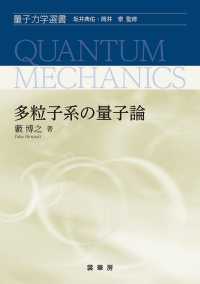- ホーム
- > 洋書
- > 英文書
- > Literary Criticism
Full Description
This book is the first monograph of its kind in the academic world which comprehensively expounds the new methodology of humanities. The quadruple-evidence method is one which integrates quadruple-evidences to open up new horizon for interpretation of ancient culture in the three-dimensional manner. The first layer of evidence refers to documents passed down from the past; the second layer of evidence refers to local written materials; the third layer of evidence includes oral legends of anthropology and folklore and etiquette in the living folk customs; the fourth layer of evidence refers to those ancient objects and images either unearthed in archaeological excavations or handed down from the past. The book consists of theoretical explorations and their applications in individual cases. While the first part studies the academic evolution, theory and methodological value of the quadruple-evidence method, the second part, in using the method in different cases, explores different historical and cultural phenomena in the history of China, attempting to extend the frontier of the origin of civilization from the approach of mythological study
Contents
The Quadruple-evidence Method in Retrospect.- The Fourth-dimension Evidence: Theoretical Legitimacy.- The Quadruple-evidence Method in Methodology.- The Owl as the Cultural Symbol from the Perspective of Comparative Iconology.- A Study of the Serial Jade Pedants Unearthed from the Dou Family's Tombs in the West Han Dynasty Based on the Inter-evidentiality.- On the Inter-evidence Again: The Jade ring Unearthed from the Tombs of the HanDynasty in Chaohu city and the Bear Totem of the Chu People.- A Third Exploration on the Evidence Interrelation: On the Myths of Heavenly Bear in the Han Dynasty.- The Chain of Evidence and the Great Tradition: An Interpretation of the Mystery of Er-snake in Classic of Mountains and Seas.- Summary and Prospect.- Reference.- Translator's Note.






